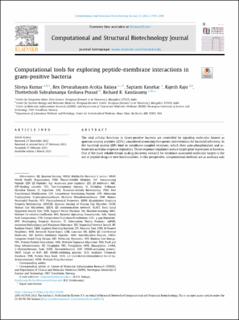| dc.contributor.author | Kumar, Shreya | |
| dc.contributor.author | Balaya, Rex Devasahayam Arokia | |
| dc.contributor.author | Kanekar, Saptami | |
| dc.contributor.author | Raju, Rajesh | |
| dc.contributor.author | Prasad, Thottethodi Subrahmanya | |
| dc.contributor.author | Kandasamy, Richard Kumaran | |
| dc.date.accessioned | 2023-11-01T07:43:57Z | |
| dc.date.available | 2023-11-01T07:43:57Z | |
| dc.date.created | 2023-04-17T14:12:08Z | |
| dc.date.issued | 2023 | |
| dc.identifier.issn | 2001-0370 | |
| dc.identifier.uri | https://hdl.handle.net/11250/3099884 | |
| dc.description.abstract | The vital cellular functions in Gram-positive bacteria are controlled by signaling molecules known as quorum sensing peptides (QSPs), considered promising therapeutic interventions for bacterial infections. In the bacterial system QSPs bind to membrane-coupled receptors, which then auto-phosphorylate and activate intracellular response regulators. These response regulators induce target gene expression in bacteria. One of the most reliable trends in drug discovery research for virulence-associated molecular targets is the use of peptide drugs or new functionalities. In this perspective, computational methods act as auxiliary aids for biologists, where methodologies based on machine learning and in silico analysis are developed as suitable tools for target peptide identification. Therefore, the development of quick and reliable computational resources to identify or predict these QSPs along with their receptors and inhibitors is receiving considerable attention. The databases such as Quorumpeps and Quorum Sensing of Human Gut Microbes (QSHGM) provide a detailed overview of the structures and functions of QSPs. The tools and algorithms such as QSPpred, QSPred-FL, iQSP, EnsembleQS and PEPred-Suite have been used for the generic prediction of QSPs and feature representation. The availability of compiled key resources for utilizing peptide features based on amino acid composition, positional preferences, and motifs as well as structural and physicochemical properties, including biofilm inhibitory peptides, can aid in elucidating the QSP and membrane receptor interactions in infectious Gram-positive pathogens. Herein, we present a comprehensive survey of diverse computational approaches that are suitable for detecting QSPs and QS interference molecules. This review highlights the utility of these methods for developing potential biomarkers against infectious Gram-positive pathogens. | en_US |
| dc.language.iso | eng | en_US |
| dc.publisher | Elsevier B. V. | en_US |
| dc.rights | Attribution-NonCommercial-NoDerivatives 4.0 Internasjonal | * |
| dc.rights.uri | http://creativecommons.org/licenses/by-nc-nd/4.0/deed.no | * |
| dc.title | Computational tools for exploring peptide-membrane interactions in gram-positive bacteria | en_US |
| dc.title.alternative | Computational tools for exploring peptide-membrane interactions in gram-positive bacteria | en_US |
| dc.type | Peer reviewed | en_US |
| dc.type | Journal article | en_US |
| dc.description.version | publishedVersion | en_US |
| dc.source.pagenumber | 1995-2008 | en_US |
| dc.source.volume | 21 | en_US |
| dc.source.journal | Computational and Structural Biotechnology Journal | en_US |
| dc.identifier.doi | 10.1016/j.csbj.2023.02.051 | |
| dc.identifier.cristin | 2141317 | |
| cristin.ispublished | true | |
| cristin.fulltext | original | |
| cristin.qualitycode | 1 | |

